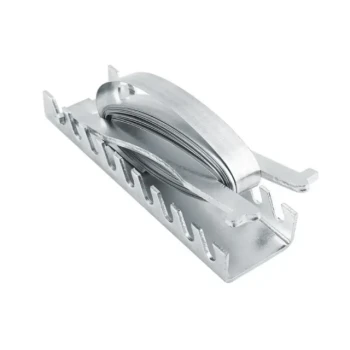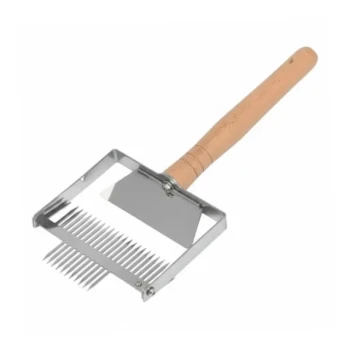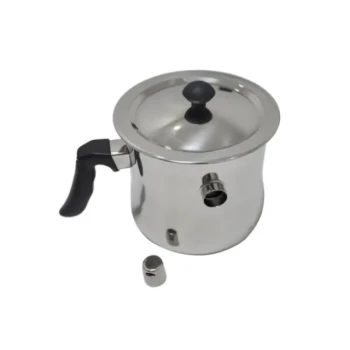To understand Varroa mites, you must look inside the honey bee nursery. An adult female mite invades a brood cell just before it is capped, lays her eggs, and her offspring then feed on the defenseless bee pupa. This process not only weakens the developing bee but also transmits deadly viruses, undermining the health of the entire colony from within.
The core threat of the Varroa mite is not just its parasitic feeding, but its reproductive strategy. By breeding inside the protected environment of a sealed brood cell, the mite ensures the next generation of bees is born weakened and diseased, creating a cycle of decline that can lead to total colony collapse.

The Mite's Lifecycle: A Hidden Invasion
The reproductive cycle of the Varroa destructor is the key to its devastating success as a parasite. The most critical phase of this cycle occurs out of sight, within the wax cells of the honeycomb where young bees develop.
Targeting the Nursery
A mated adult female Varroa mite, known as a foundress mite, detaches from an adult bee and enters a brood cell containing a bee larva. She specifically targets a cell right before the worker bees seal it with a wax capping for the pupal stage.
Laying the Foundation
Once safely sealed inside, the mother mite begins to lay her own eggs. These eggs hatch, and the new mites mature and mate with each other within the confines of the cell.
Feeding on the Defenseless
Throughout this entire period, the original mother mite and her newly hatched offspring feed on the bee pupa. They target the bee's fat bodies, which are vital organs responsible for immune function, pesticide detoxification, and energy storage.
The Devastating Impact on Honey Bee Colonies
The damage caused by Varroa is twofold: the direct physical harm from feeding and the indirect, often more lethal, harm from disease transmission. This combination is what makes the mite the single greatest threat to honey bees worldwide.
Weakened Bees and Shorter Lifespans
Bees that emerge from infested cells are often smaller and have a significantly shorter lifespan. The damage to their fat bodies during development compromises their health and resilience for their entire lives.
The Vector for Disease
As the mites feed, they create open wounds on the bees, which serve as perfect entry points for viruses. Varroa mites are known vectors for numerous honey bee viruses, most notably the Deformed Wing Virus (DWV). A mite infestation can turn a low-level, manageable virus infection into a deadly epidemic within the colony.
Phoretic vs. Reproductive Mites
The mites you might see on the back of an adult bee are in the "phoretic" stage, simply using the bee for transportation. The real damage is caused by the reproductive mites hidden away inside the brood cells, actively multiplying and weakening the next generation.
Understanding the Pitfall of Visual Inspection
Because the majority of a colony's Varroa mite population is hidden within sealed brood cells, beekeepers face a significant challenge in assessing the true level of infestation.
Why You Can't Trust Your Eyes
Relying solely on seeing mites on adult bees will lead to a dangerous underestimation of the problem. By the time mites are easily visible on many bees, the infestation level within the brood is likely already at a critical, potentially irreversible, stage.
The High Cost of Inaction
Failing to actively monitor mite levels is the primary reason for unexpected colony losses. Without regular monitoring and effective management, a Varroa infestation will almost invariably weaken and destroy a honey bee colony.
Making the Right Choice for Colony Health
Understanding the Varroa mite's reproductive cycle is the first step toward effective management and ensuring the long-term survival of your bees.
- If your primary focus is understanding the mite's lifecycle: Recognize that the real damage happens unseen within the sealed brood cells, directly impacting the health of the next generation of bees.
- If your primary focus is maintaining a healthy colony: Implement a consistent monitoring plan to measure mite populations, as simple visual inspection is not enough to prevent colony collapse.
Properly managing this parasite is the defining challenge of modern beekeeping, but it is a challenge that can be met with knowledge and vigilance.
Summary Table:
| Mite Stage | Location | Primary Impact |
|---|---|---|
| Foundress Mite | Sealed Brood Cell | Lays eggs on bee pupa |
| Offspring Mites | Sealed Brood Cell | Feed on bee's fat bodies |
| Phoretic Mites | Adult Bee's Back | Transportation only |
| Reproductive Mites | Brood Cells | Weaken bees & transmit viruses |
Protect your apiary from Varroa mite devastation. HONESTBEE supplies commercial apiaries and beekeeping equipment distributors with wholesale-focused solutions for effective mite monitoring and management. Contact our experts today to discuss durable, reliable supplies that safeguard your colony's health and productivity.
Visual Guide

Related Products
- Economy Galvanized Beekeeping Honey Bee Smoker for Wholesale
- Professional Bee Smoker with Elongated Spout and Durable Bellows for Beekeeping
- Professional Insulated Winter Hive Wrap for Beekeeping
- Wooden Queen Bee Excluder for Beekeeping
- Commercial Grade Vertical Electric Bee Sweeper for Bee Removal
People Also Ask
- What is a Smoker and how is it used in beekeeping? The Essential Tool for Calm, Safe Hive Inspections
- What are the common design features of a bee smoker? Choose the Right Smoker for Your Apiary
- What are some alternatives to using smoke in beekeeping? A Guide to Gentle Hive Management
- How did early beekeepers use bee smokers? Master Ancient Bee Calming Techniques
- What is a bee smoker and what is its primary purpose? Master Safe Hive Inspections



















